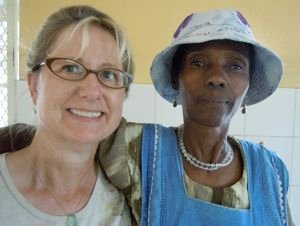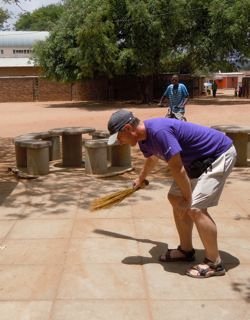This morning Deb and I met Monica Kribs, a volunteer for the Naledi Baptist Fellowship, at the offices of Flying Mission. Monica each weekday helps prepare and serve food for 75 to 100 children at the Tlamelo Feeding Project in Old Naledi, a poor suburb at the outer fringe of Gaborone. We accompanied her to help out and to learn about the work.
After stopping at a Fruit and Veg market to buy carrots, beets, and butternut squash, we arrived at the kitchen for the project to find several women already hard at work chopping and preparing today’s lunch. They needed some oil and a soup mix, so Monica and Deb and I walked a few blocks to a collection of stores to purchase the items. Part of Monica’s ministry and work involves paying for such items out of money donated by her family and church in Redmond, Oregon, amounting to between 200 and 400 pula a week, which converts to between $30 and $60. At the first market, a woman was washing the aisle where the oil was located, and she said we couldn’t walk on that aisle, because the floor was wet. Undaunted, Monica walked across the square to another store to purchase the items. This is as much a tribute to the level of cleanliness we found in Old Naledi, as it is to a remarkably casual attitude toward the needs of a customer.
 Back at the kitchen, we began to chop. Deb and I were on carrots, Monica on butternut squash. I loved chopping those carrots. My training consisted of Monica’s guidance to chop the pieces very small, so that they would not be evident to the children, who apparently don’t like carrots. Once when the stealth vegetable was broccoli, Monica after the meal spotted a long green line of broccoli pieces that had been rejected by the children and left on the ground. I didn’t have a chance to see if my carrots met the kids-aversion test, because we were actually adding to inventory for future lunches. Our carrot pieces went into plastic bags placed in a big freezer off the main room of the kitchen.
Back at the kitchen, we began to chop. Deb and I were on carrots, Monica on butternut squash. I loved chopping those carrots. My training consisted of Monica’s guidance to chop the pieces very small, so that they would not be evident to the children, who apparently don’t like carrots. Once when the stealth vegetable was broccoli, Monica after the meal spotted a long green line of broccoli pieces that had been rejected by the children and left on the ground. I didn’t have a chance to see if my carrots met the kids-aversion test, because we were actually adding to inventory for future lunches. Our carrot pieces went into plastic bags placed in a big freezer off the main room of the kitchen.
The daily amount of food prepared is impressive. Huge metal bowls of rice and meat were involved. Monica said it’s difficult to know exactly how many children will show up for the meal. They need to be on the Social Services record as eligible, but there is no government money going to the project. When the carrots were finished, I visited with Mathata Mosekwa, 29, who is the project’s only full-time employee. He said it is supported by donations from individuals, local businesses, and other private sources. Related activities for the children include sports and counseling. 
“For most of the kids, this is the only meal of the day,” Monica told us on the way to Old Naledi. Nationwide, 90 percent of children in Botswana live in single-parent families. Of those between the ages of 15 and 50, 38 percent have AIDS. Forty-five percent of the population of Botswana is 15 years old or younger. Monica has served several tours of volunteer work in Botswana, after a career in the
medical field, mainly as a computer technician. She lives in Gabarone for about $1,000 a month. When I asked her why she does it, she replied, “The children. I love these children. That’s what keeps me here even on the very hardest days.”
As work in the kitchen reached a crescendo of wonderful smells and hearty food nearly ready to eat, Mathata Mosekwa gathered the children under a big tree across the yard. He told them a story in Setswana, the national language of Botswana, although the official language is English. The kids crowded as close to Mathata as they could get, and when he asked questions as part of the story, there were lots of volunteered answers. When the story was over, the kids all closed their eyes and recited the Lord’s Prayer, in English.
Then lunch was served. The children first washed their hands at a big soapy tub, one by one. An older child poured water over the hands of the young ones, who then proceeded to a window to reach up for a plate of steaming hot rice, meat, and what looked like a beets mash to my eye. They ate mostly with their hands, since there were just a few forks available, and some shared their food with others, sliding portions off one plate onto another.
After everyone had eaten, Deb, Monica, and I moved from chopping vegetables to cleaning plates and utensils. I was the washer, Monica was the rinser, and Deb dried. The plates were attractive and durable metal plates painted in bright colors. I have a vague idea that 100 is a lot of kids, but the scale was made clearer to me as I tried to keep up with a seemingly never-ending supply of plates coming into the kitchen for washing. One thing we noticed is that there was no food thrown away. Everything got
eaten, if not by the child to whom it was originally served.
Everything also got cleaned, in some cases more than once. Between the chopping and the dish washing, I had a chance to try one of the very short brooms. A boy was sweeping the entire patio around the kitchen building, and I tried to follow his lead. We swept the concrete patio, and then he began sweeping the dirt below it, which impressed me. Whoever invented long handles for brooms did a great service to backs all over the world, I can tell you. By the time we left with Monica, the kitchen building was spotless, all the dishes cleaned and the leftovers saved for future use. And the patio was being swept again by different kids with the very short brooms.
Deb and I left very impressed with the amount of work it takes to feed a hundred children one meal on
one day of the year. It was a tiring day, and it made us appreciate the dedication of Monica and the other volunteers, who do this work every single weekday of the school year. I found myself imagining all the children of the developing world, having meals prepared for them each day in many cases by volunteers such as these. When it gets down to the level of chopping carrots, washing the dishes, and sweeping the floor, you get a feel for what’s involved in “programs,” a very abstract term compared with the actual people helping and being helped in specific places on real days of the year all over the world.
I’m grateful to Deb for setting up this rewarding stop on our stay in Botswana. Tomorrow we will be up early to drive two hours to a diamond mine at Jwaneng for a tour that Jim set up for us.
 Send to Kindle
Send to Kindle






